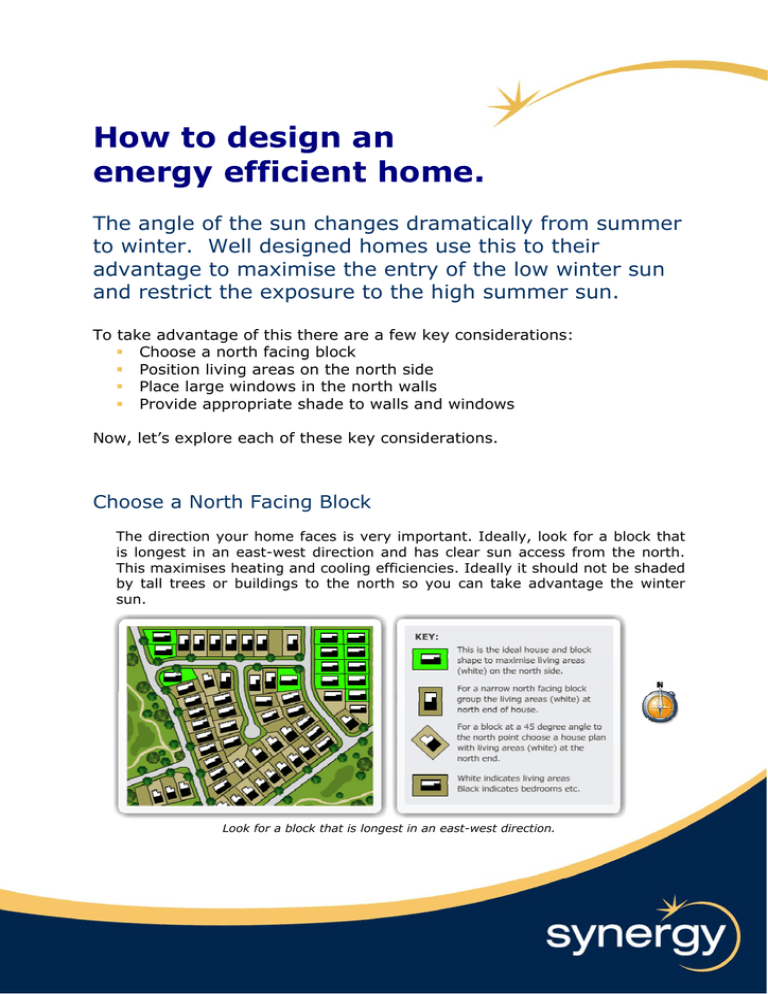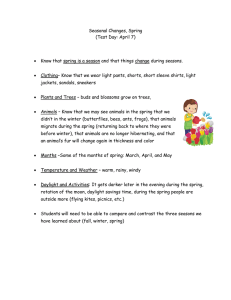How to design an
advertisement

How to design an energy efficient home. The angle of the sun changes dramatically from summer to winter. Well designed homes use this to their advantage to maximise the entry of the low winter sun and restrict the exposure to the high summer sun. To take advantage of this there are a few key considerations: Choose a north facing block Position living areas on the north side Place large windows in the north walls Provide appropriate shade to walls and windows Now, let’s explore each of these key considerations. Choose a North Facing Block The direction your home faces is very important. Ideally, look for a block that is longest in an east-west direction and has clear sun access from the north. This maximises heating and cooling efficiencies. Ideally it should not be shaded by tall trees or buildings to the north so you can take advantage the winter sun. Look for a block that is longest in an east-west direction. Position living areas on the north side As much as possible, choose a plan that has your living areas facing north and your bedrooms facing south. In winter, your living rooms catch maximum sun for warmth and light, while in the heat of summer your bedrooms are shielded from the sun for cooler sleeping conditions. Place large windows in the north walls Windows are used to light rooms naturally, create cross breezes and provide views, however they also transfer a lot heat in and out. It is important to carefully consider their placement, size and sun protection, so you can enjoy all their benefits without sacrificing comfort. Try to have most of your windows facing north, and if possible make your north wall about 1/3 to 1/2 glass. This way winter sun will be able to enter and naturally warm your home but can easily be protected from summer sun by eaves, deciduous plants or pergolas. East facing windows should be kept to a minimum and as small as practical. In winter, they don’t receive enough sun to provide warmth yet they let valuable heat out. In summer, they can cause the house to heat quickly as they receive morning sun and are difficult to shade effectively. South facing windows get virtually no direct sun all year, but can cause major heat loss during winter. They should be modest in size – small enough to limit heat transfer in winter yet big enough to allow cross-breezes in summer. West facing windows should be kept to a minimum as they receive full, hot afternoon sun and are very hard to shade. If needed for views, position them under a veranda or carport and apply vertical screens. Trees on the west side should be tall varieties that will shade the home but still allow westerly breezes underneath. To trap in the heat during winter evenings and to keep the home cool on hot summer days, all windows should have good curtains with close-fitting pelmets or pleated blinds that fit inside the windows. It is best to keep some windows open to catch cooling breezes on summer nights, so security screens are worth considering for this purpose Provide shade to the north walls Eaves Correctly sized and placed, overhanging eaves can keep the scorching summer sun out while letting the low winter sunshine stream in – essential for a liveable, all-season home. Correctly sized eaves will provide a balance between winter sun and summer shade. As a guide to the size of the overhang you need, measure the distance from the line of the eaves to the bottom of the window and multiply that figure by 0.7. In Perth, Western Australia, this delivers adequate shade from September until March. Trees and Shrubs Strategically placed trees and shrubs can make your home more comfortable by maximising the cooling shade and breezes in summer while letting the sun shine through in winter. On the north side use deciduous trees, that will shade the windows in summer but allow the winter sun to shine into the home. To enjoy winter sunshine, keep north facing windows clear to the sun and avoid planting evergreen trees that will block winter sun. Deciduous trees allow winter sun to warm the home but keep out summer heat Trees and shrubs are great for minimising heat gain through east and west walls in the summer. Tall evergreen trees on the west side offer shade from the hot afternoon sun and still allow cool sea breezes to flow underneath. Remember to allow for the fully-grown height and width of trees when planning a garden. Avoid planting tall trees so close to the house that branches can drop on your roof during storms. Keep trees away from power lines. Brick paving under north facing windows reflect summer heat into the home. Place paving further away from the house and use water-wise groundcovers and small shrubs beneath the windows as a cooler option. Verandahs and pergolas These can also provide extra summer shade. Pergolas with slats at the correct angle can let in the low winter sun while providing shade in summer. Removable shade cloth, or deciduous vines over a pergola, can achieve a similar effect. If space is a problem, vines grown on latticework are great too! You can find an interactive presentation of all of these principles at www.synergy.net.au/envirohome Want even more energy efficient ideas for your home and other ways to help the environment? Energy Calculator With Synergy’s Energy Calculator you can calculate what each appliance in your home costs you to run and what is costs the environment. Tour our virtual home, read the tips on each appliance and check out what your appliances use at www.synergy.net.au/calculator. Better Globes Calculator Fluorescent globes are much more energy efficient than the normal incandescent globes, so they save you money and save the environment. See how you can save up to 80% of the cost of lighting your home. Go to www.synergy.net.au/betterglobes. SmartPower In a similar way to how off-peak telephone rates work, by shifting some of your electricity usage to off-peak times, you could save on your energy bill. Find out what is involved at www.synergy.net.au/smartpower. Other ways to save There are many other ways to save. Check out the tips on air conditioning, cooking, standby power and don’t miss our Top Tips page. For links to all our energy efficiency pages go to www.synergy.net.au/save The house design suggestions above and on our website, apply to the climatic conditions in the southern half of Western Australia, but may also be suitable for similar climates in other parts of the southern hemisphere. This information subject to change without notice
